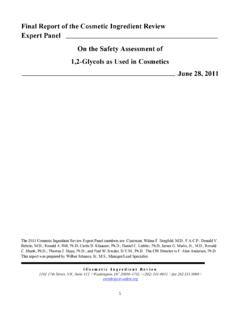Transcription of Citric Acid and Its Inorganic Salts and Alkyl and …
1 Scientific Literature review Citric acid and Its Inorganic Salts and Alkyl and Glycol Esters as Used in Cosmetics June 9, 2011 All interested persons are provided 60 days from the above date to comment on this Scientific Literature review and to identify additional published data that should be included or provide unpublished data which can be made public and included. Information may be submitted without identifying the source or the trade name of the cosmetic product containing the ingredient.
2 All unpublished data submitted to CIR will be discussed in open meetings, will be available at the CIR office for review by any interested party and may be cited in a peer-reviewed scientific journal. Please submit data, comments, or requests to the CIR Director, Dr. F. Alan Andersen. The 2011 Cosmetic Ingredient review Expert Panel members are: Chair, Wilma F. Bergfeld, , ; Donald V. Belsito, ; Ronald A. Hill, ; Curtis D. Klaassen, ; Daniel Liebler, ; James G. Marks, Jr., , Ronald C. Shank, ; Thomas J.
3 Slaga, ; and Paul W. Snyder, , The CIR Director is F. Alan Andersen, This report was prepared by Monice M. Fiume, Senior Scientific Analyst/Writer and Bart A. Heldreth, , Chemist. Cosmetic Ingredient review 1101 17th Street, NW, Suite 412 Washington, DC 20036-4702 ph fax TABLE OF CONTENTS Introduction .. 1 Chemistry .. 1 Definition, Structure, Properties, and Production .. 1 Impurities/Composition .. 3 Use .. 4 Cosmetic .. 4 Non-Cosmetic .. 5 Toxicokinetics .. 5 In Vitro.
4 5 Oral .. 6 Effect on Transdermal Absorption .. 6 Toxicological studies .. 6 Single Dose (Acute) Toxicity .. 6 Repeated Dose Toxicity .. 6 Oral .. 6 Intraperitoneal .. 7 Reproductive and Developmental Toxicity .. 8 Oral .. 8 In-Vitro .. 8 Spermicidal Effects .. 8 Genotoxicity .. 8 Anti-Mutagenic Effects .. 9 Carcinogenicity .. 9 Irritation and Sensitization .. 9 Skin Irritation/Sensitization .. 9 Mucosal Irritation .. 9 Case Reports .. 10 Miscellaneous studies .. 10 Effects in Skin .. 10 Lipid Bilayer Permeation.
5 11 Cough Reflex .. 11 Anesthetic Effects .. 12 Information Sought .. 12 Summary .. 12 Tables .. 14 Table 1. Definitions and structures of Citric acid , salt and esters .. 14 Table 2. Chemical and physical properties .. 21 Table 3. Reported functions of Citric acid and its Salts and esters .. 25 Table 4a. Frequency and concentration of use according to duration and type of exposure .. 26 Table 4b. Ingredients not reported to be used .. 29 Table 5. Examples of non-cosmetic uses .. 29 Table 6. Acute toxicity studies.
6 30 Table 7. Genotoxicity studies .. 31 Table 8. Dermal irritation and sensitization .. 33 Table 9. Mucosal irritation studies .. 37 References .. 38 1 INTRODUCTION This report reviews the safety of Citric acid , an -hydroxy tricarboxylic acid , as used in cosmetics. Citric acid may function in cosmetics as a chelating agent, pH adjuster, or fragrance ingredient. This report also addressed the safety of the following 12 Inorganic Salts , 20 Alkyl esters, and 13 glycol esters of Citric acid as used in cosmetics.
7 Inorganic SaltsAluminum Citrate Calcium Citrate Copper Citrate Diammonium Citrate Disodium Cupric Citrate Ferric Citrate Magnesium Citrate Manganese Citrate Monosodium Citrate Potassium Citrate Sodium Citrate Zinc Citrate Alkyl Mono-, Di-, and TriestersIsodecyl Citrate Isopropyl Citrate Stearyl Citrate Dilauryl Citrate Distearyl Citrate Tributyl Citrate Tri-C 12-13 Alkyl Citrate Tri-C14-15 Alkyl Citrate Tricaprylyl Citrate Triethyl Citrate Triethylhexyl Citrate Trihexyldecyl Citrate Triisocetyl Citrate Triisopropyl Citrate Trilauryl Citrate Trioctyldodecyl Citrate Trioleyl Citrate Triisostearyl Citrate Tristearyl Citrate Ethyl Citrates Glycol Mono-, Di.
8 And TriestersDisodium Laureth-7 Citrate Laureth-6 Citrate Laureth-7 Citrate Propylene Glycol Citrate Dilaureth-7 Citrate Sodium Dilaureth-7 Citrate PEG-5 Tricapryl Citrate PEG-5 Trilauryl Citrate PEG-5 Trimyristyl Citrate PEG-5 Tricetyl Citrate PEG-5 Tristearyl Citrate Trilaureth-9 Citrate Tripropylene Glycol Citrate While some of the Inorganic Salts of Citric acid may function as a pH adjuster or chelating agent, as Citric acid does, these Salts also have many diverse functions, including skin conditioning agent, buffering agent, cosmetic astringent, oral care agent, cosmetic biocide, or pesticide.
9 The Alkyl esters function primarily as skin conditioning agents, but a few have other possible functions, including plasticizer, solvent, and fragrance ingredient. The glycol esters of Citric acid are reported to function mostly as skin conditioning agents or surfactants. Citric acid , calcium citrate, ferric citrate, manganese citrate, potassium citrate, sodium citrate, diammonium citrate, and triethyl citrate are generally recognized as safe (GRAS) direct food additives. Therefore, the oral safety of these ingredi-ents has been well substantiated.
10 Since these ingredients have been shown to be safe for ingestion, this report will focus on the dermal application of these ingredients. For the other ingredients, all available data will be included. CHEMISTRY Definition, Structure, Properties, and Production Citric acid (2-hydroxy-1,2,3-propanetricarboxylic acid ), is a common metabolite of plants and animals, and is well known for its part in the Krebs It precipitates as white, translucent crystals of monoclinic holohedra form. Citric acid 2 is a polyprotic, -hydroxy acid (AHA).
